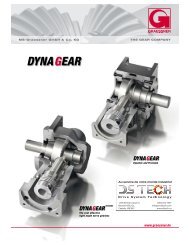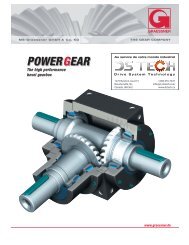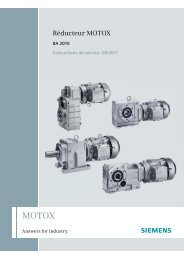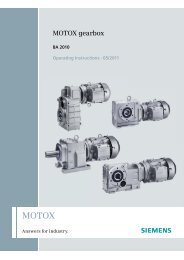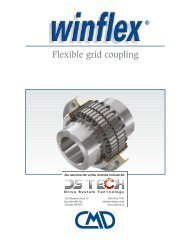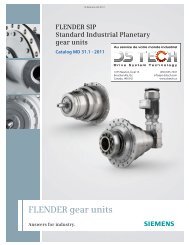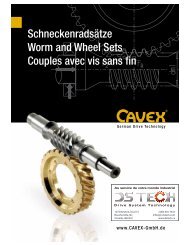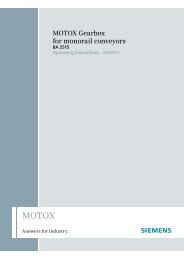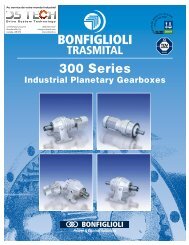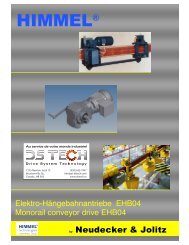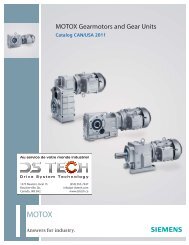FLENDER Standard Couplings - DS TECH
FLENDER Standard Couplings - DS TECH
FLENDER Standard Couplings - DS TECH
- No tags were found...
You also want an ePaper? Increase the reach of your titles
YUMPU automatically turns print PDFs into web optimized ePapers that Google loves.
© Siemens AG 2011<br />
<strong>FLENDER</strong> <strong>Standard</strong> <strong>Couplings</strong><br />
Coupling Preselection and Options<br />
Selection of the coupling size<br />
1275 Newton, local 15<br />
Boucherville, Qc,<br />
Canada, J4B 5H2<br />
Coupling load under maximum and overload conditions<br />
The maximum torque is the highest load acting on the coupling<br />
in normal operation.<br />
Maximum torques at a frequency of up to 25 times an hour are<br />
permitted and must be lower than the maximum coupling torque.<br />
Examples of maximum torque conditions are: Starting operations,<br />
stopping operations or usual operating conditions with<br />
maximum load.<br />
T Kmax ≥ T max ⋅ FT<br />
Overload torques are maximum loads which occur only in combination<br />
with special, infrequent operating conditions.<br />
Examples of overload torque conditions are: Motor short circuit,<br />
emergency stop or blocking because of component breakage.<br />
Overload torques at a frequency of once a month are permitted<br />
and must be lower than the overload torque of the coupling. The<br />
overload condition may last only a short while, i.e. fractions of a<br />
second.<br />
T KOL ≥ T OL ⋅ FT<br />
Coupling load due to dynamic torque load<br />
Applying the frequency factor, the dynamic torque load must be<br />
lower than the coupling fatigue torque.<br />
Dynamic torque load<br />
T KW ≥ T W ⋅ FF ⋅<br />
1.5<br />
FB – 1.0<br />
Frequency of the dynamic torque load<br />
f err ≤ 10 Hz frequency factor FF = 1.0<br />
Frequency of the dynamic torque load<br />
f err >10Hz frequency factor FF=√ (f err /10 Hz)<br />
For the ZAPEX and ARPEX series, the frequency factor is always<br />
FF = 1.0.<br />
Checking the maximum speed<br />
For all load situations n Kmax ≥ n max<br />
Checking permitted shaft misalignment<br />
For all load situations, the actual shaft misalignment must be less<br />
than the permitted shaft misalignment.<br />
Checking bore diameter, mounting geometry and<br />
coupling design<br />
The check must be made on the basis of the dimension tables.<br />
The maximum bore diameter applies to parallel keyways to<br />
DIN 6885. For other keyway geometries, the maximum bore<br />
diameter can be reduced. On request, couplings with adapted<br />
geometry can be provided.<br />
Coupling behavior under overload conditions<br />
The ZAPEX, ARPEX, N-EUPEX, RUPEX and BIPEX coupling series<br />
can withstand overloads until the breakage of metal parts.<br />
These coupling series are designated as fail-safe.<br />
The N-EUPEX <strong>DS</strong>, ELPEX-B, ELPEX-S and ELPEX coupling series<br />
throw overload. The elastomer element of these couplings is<br />
irreparably damaged without damage to metal parts when subjected<br />
to excessive overload. These coupling series are designated<br />
as non-fail-safe. These types that fail can be fitted with a<br />
so-called fail-safe device. This additional component enables<br />
emergency operation, even after the rubber element of the coupling<br />
has been irreparably damaged.<br />
Checking shaft-hub connection<br />
The torques specified in the tables of power ratings data of the<br />
coupling series do not necessarily apply to the shaft-hub connection.<br />
Depending on the shaft-hub connection, proof of form<br />
stability is required. Siemens recommends obtaining proof of<br />
form strength by using calculation methods in accordance with<br />
the current state of the art.<br />
Shaft-hub connection<br />
Keyway connection to DIN 6885-1 DIN 6892<br />
Shrink fit DIN 7190<br />
Spline to DIN 5480<br />
Bolted flange connection VDI 2230<br />
Flange connection with close-fitting bolts<br />
Suggestion for calculation<br />
method<br />
Fitting recommendations for the shaft-hub connection are given<br />
in catalog section 15.<br />
The coupling hub is frequently fitted flush with the shaft end face.<br />
If the shaft projects, the risk of collision with other coupling parts<br />
must be checked. If the shaft is set back, in addition to the loadbearing<br />
capacity of the shaft-hub connection, the correct positioning<br />
of the hub must be ensured as well. If the bearing hub<br />
length is insufficient, restorative forces may cause tilting movements<br />
and so wear to and impairment of the axial retention. Also,<br />
the position of the set screw to be positioned on sufficient shaft<br />
or parallel key material must be noted.<br />
Checking low temperature and chemically aggressive<br />
environment<br />
The minimum permitted coupling temperature is specified in the<br />
Temperature factor FT table. In the case of chemically aggressive<br />
environments, please consult the manufacturer.<br />
3<br />
(450) 655-7447<br />
info@pt-dstech.com<br />
www.dstech.ca<br />
Siemens MD 10.1 · 2011<br />
3/7



